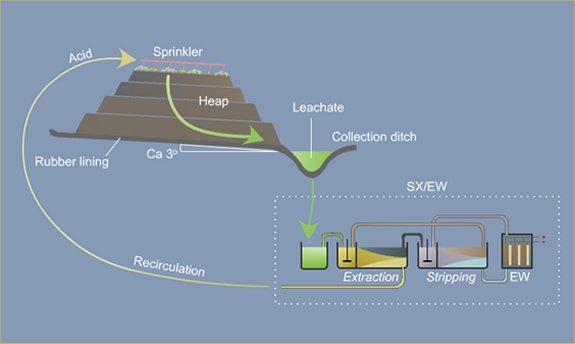In heap leaching, how can we determine if the ore at the middle and bottom of the heap has been fully leached?
The recommendation for a rectangular heap is to improve water permeability. To determine whether all the ore has been fully permeated, small barriers can be created on the surface of the heap, similar to paddy fields, and the water level in each barrier can be observed to assess the quality of permeation. In the initial stages, excavators can be used to turn over the heap to avoid this issue.
Determining Leaching Efficiency in Heap Leaching
Determining if the ore at the middle and bottom of a heap has been fully leached is a significant challenge in heap leaching operations. Due to the inherent heterogeneity of the heap and the difficulty in accessing its interior, direct measurement is impractical. However, several indirect methods can be employed to assess leaching efficiency:
Indirect Methods for Determining Leaching Efficiency
Solution Analysis:
Pregnant Solution Analysis: Monitoring the gold concentration in the pregnant solution over time can provide indications of leaching efficiency. A declining gold concentration may suggest decreasing extraction rates.
Tailings Solution Analysis: Analyzing the gold content in the tailings solution can help identify potential gold losses.
Heap Characterization:
Core Sampling: Drilling core samples from different depths within the heap can provide information about gold distribution and leaching progress. However, this method is destructive and expensive.
Geophysical Surveys: Techniques like electrical resistivity tomography can be used to map variations in conductivity within the heap, which may correlate with leaching patterns.
Hydrological Modeling:
Simulating water flow through the heap can help predict leaching patterns and identify potential issues.
Pilot Testing:
Conducting small-scale column leaching tests using representative ore samples can provide insights into leaching kinetics and predict full-scale heap performance.
Metallurgical Accounting:
Tracking the overall gold recovery and comparing it to expected recoveries based on ore grade can provide an indication of leaching efficiency.
Challenges and Considerations
Heterogeneity of the Heap: Variations in ore characteristics, particle size, and water distribution within the heap can significantly impact leaching results.
Time Delays: It often takes several months for the leaching solution to reach the bottom of the heap, making it difficult to assess leaching efficiency in real-time.
Cost: Some methods, such as core sampling and geophysical surveys, can be expensive.
By combining these methods and carefully analyzing the results, it is possible to obtain a reasonable estimate of leaching efficiency in the middle and bottom sections of a heap. However, it's important to recognize that there will always be uncertainties due to the complex nature of heap leaching.
- Random article
- Popular articles
- Popular comments
- Optimal Flotation Process for Copper Ore (Partial Priority+Mixed)
- Iron ore reverse flotation process
- Iron Ore Combined Beneficiation Process
- Gravity combined beneficiation process for black and white tungsten ore
- Lithium ore reverse flotation process
- Manganese ore washing to achieve the best results
- Manganese Ore Separation: Gravity and Magnetic Methods
















Leave a message with your needs or comments
Add comment: